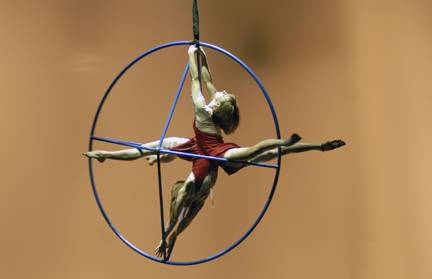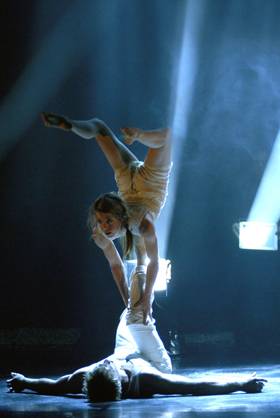 “Acrobatics is mainly intelligence. Intelligence and beauty.”
“Acrobatics is mainly intelligence. Intelligence and beauty.”
This statement, said to the audience by a member of the Cirque Éloize ensemble, proved to be true in the group’s well-crafted Krannert Center performance.
Cirque Éloize performed Nebbia, a show that explores the world of dreams and the imaginary, on Tuesday evening. Meaning “fog” in Italian, Nebbia is the last section of the Sky Trilogy, a production directed by Daniele Finzi Pasca. Unlike the earlier sections of the trilogy, Nomade and Rain, Nebbia was created as a joint production with Teatro Sunil, Pasca’s own Swiss clown troupe.
Clowning and narrative were braided with elements of acrobatics and aerial dance to create a visually and mentally stimulating show. Performers addressed the audience intermittently, encouraging participation and individual contribution. Such interactions allowed for the development of a friendly rapport between performers and audience members, fostering a communal atmosphere.
The breaks also furthered Nebbia‘s narrative structure. Ensemble members told stories about their home country, a place where death could be lurking around any corner. In this country, people always say goodbye as if they are saying it for the last time, waving white handkerchiefs at one another through dense fog.
A sense of community manifested itself in a variety of ways as it was laced throughout acts. In many instances, ensemble members provided live musical accompaniment onstage while acrobatic solos or duets were performed.
 It is notable that every member of the ensemble of Cirque Éloize doubles as an acrobat and a musician during the show. Entertainers that have a high skill level in multiple disciplines are rare, yet Nebbia features eleven. Seven different nationalities are present in the group, which gives them a wide base of training styles. It also adds a multicultural dimension to the show, as different languages were used in song and spoken word.
It is notable that every member of the ensemble of Cirque Éloize doubles as an acrobat and a musician during the show. Entertainers that have a high skill level in multiple disciplines are rare, yet Nebbia features eleven. Seven different nationalities are present in the group, which gives them a wide base of training styles. It also adds a multicultural dimension to the show, as different languages were used in song and spoken word.
The use of voice and breath created a strong energy flow between performers and provided a sense of emotional support. The presence of the ensemble was also visually stimulating, oftentimes occupying the space below a suspended acrobat.
Featured acrobatic elements included aerial dance performed with silks, trapeze, and hoop, as well as trampoline and hula hoop acts. The ensemble in Cirque Éloize demonstrated an outstandingly professional level of technique and artistry throughout the show. A fine-tuned sense of musicality, pacing, choreographic content, and performance quality allowed the group to showcase their skills without flaunting them.
Breathtaking displays of flexibility, fluidity, and strength were executed in an aesthetically simple way. Individual performers were highlighted as the evening progressed through the presentation of solos and small group choreography. In each piece, focus was well-directed from the main acrobatic act to elements of the community and back again. Many times the ensemble’s humorous subplots continued beneath the highlighted performers.
In one subplot, the men in the ensemble participated in a follow-the-leader lesson of karate. The audience giggled as the men floated in and out of serious concentration, often hitting one another with misdirected self-defense. Their devoted imitation floundered, however, when the instructor dropped into a split. Such elements of play and surprise evoked laughter from the audience on many occasions.
In a quick-paced vibraphone duet, performers Andrée-Anne Gringras-Roy and Nicola Marinoni sampled a wide range of classical music, while occasionally defending themselves against pebble-like objects that fell from the sky. With Rimsky-Korsakov’s “Flight of the Bumblebee” as their home base, the players introduced themes from famous works by Schubert, Beethoven, and Rossini, among others. The falling pebbles increased throughout the playful piece until they were raining down on the duet from all angles. The musicians fled the space, leaving only the vibraphone onstage in the middle of the pebble rainstorm. The audience clapped along with recorded music as they watched the choreography of falling stones. Vertical space onstage was used effectively in other acts as well.
The show’s trampoline act concealed the vertical space of the theater. Selective visibility allowed for the sudden appearance of dangling feet, mysteriously suspended above the trampoline. It also helped performers to disappear into the upper atmosphere after impressively high jumps. A brilliant duet between two men highlighted multiple airborne turns and twists as they played with the idea of replacing one another, both in vertical and in horizontal space. Eventually, a bar was revealed high above the trampoline. It was equally as impressive to watch acrobats make the leap to and from the bar as it was to anticipate their disappearances and reappearances when the bar was concealed.
With its strong elements of choreographic artistry and narrative, as well as its sheer diversity in acrobatic acts, Nebbia is both an intelligent and a beautiful production.








